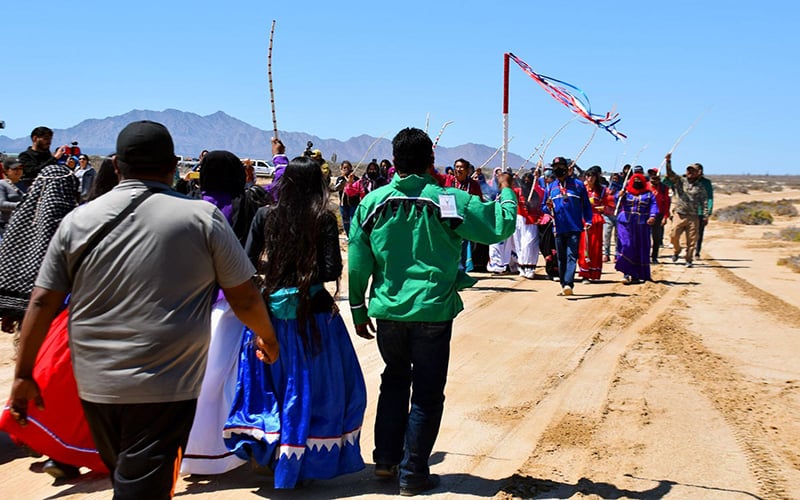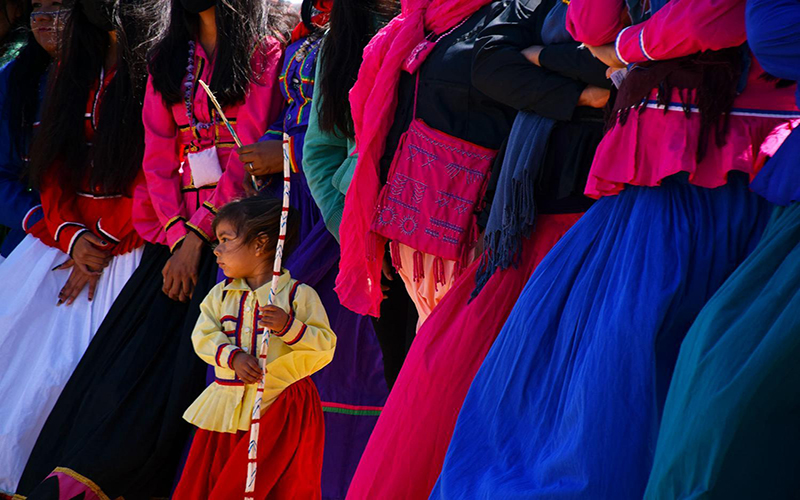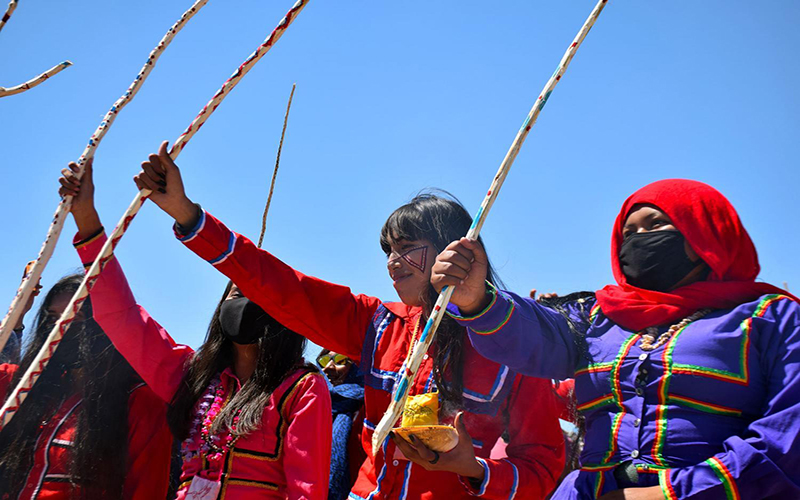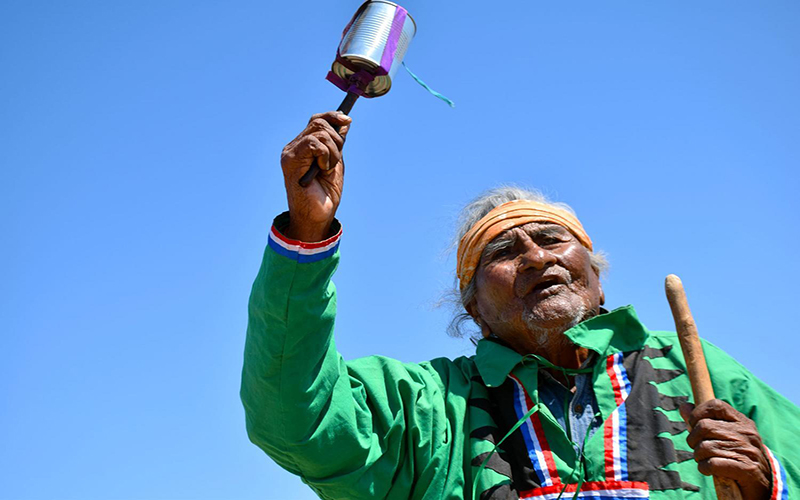Separated by more than 40 miles of rough desert road along the Sea of Cortez, members of the Comcaac Nation from El Desemboque and Punta Chueca left their homes at 4 a.m. Saturday, their path lit only by moonlight.
Some walked nearly eight hours to reach their destination, an ancestral meeting place between the two villages known as Saaps, or Playa Dos Amigos – a pristine beach surrounded by towering cardon cactus.
With the wind kicking up dust around them in the midday sun, family members and friends cheered, embraced and lifted ceremonial sticks in the air, a sign of victory and brotherhood in honor of the historic reunion of the two Comcaac communities.
“It’s been many years since the community has gathered this way,” said Miguel Estrella Romero, traditional governor of Isla del Tiburón, Mexico’s largest island. “And for me, it’s a success that we’ve come to camp here again, where our ancestors used to hold sacred ceremonies long ago.”
Soon, the crowd of more than 100 people gathered in a large circle, listening to leaders speak first in Cmiique iitom, the Comcaac language.
Then, Francisco Fonseca, a tribal representative to the Sonoran municipality Pitiquito, continued in Spanish so the “cocsar,” or non-Indigenous people, could understand.
“This walk has a purpose for our community,” he said. “We made this trek to unite our two villages in harmony and in the fight we find ourselves in now. Why? Because the white man, the government, has not given us prosperity, hasn’t helped us, hasn’t provided for our right to water, our right to health. Today, our leaders are going to work on that, and our community will be behind them. Today, we declare the fight for our communities!”
The crowd rang out in applause and shouts of support that became celebratory song and dance.
“This is what I want, what the leaders say, that there will be no more problems between our people,” said Adolfo Burgos Felix, an elder who has served as the master of dance and song in El Desemboque and who led many songs during the reunion. “I am singing now because I have the pure spirit of joy today.”
Like many in the community, he said the meeting in Saaps represents reconciliation between the two villages, which have clashed in recent years.
Water scarcity
It’s also a return to the ways of their ancestors, who walked these sacred lands out of necessity, searching for food and water.
“There weren’t nomads just to be nomads,” said Mayra Estrella of El Desemboque. “And now we’re back here because we are in need. Right now, in both communities, we’re living without water.”
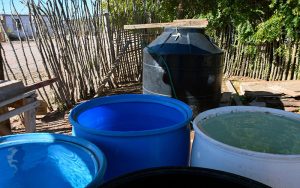
Because potable water is scarce in Punta Chueca, some people pay to have large tanks and drums outside their homes filled with water. (Photo by Kendal Blust/KJZZ)
The shortage in El Desemboque started in December, when a pump for the well that has served the community for years broke because of power instability. Facing economic hardship during the COVID-19 pandemic, the town has accumulated several thousand dollars in debt with Mexico’s electricity commission.
“And in the middle of the pandemic, they cut us off,” Estrella said. “From my point of view, you can’t deny anyone water. And that is what’s happening to our people now.”
Electricity has been restored, but El Desemboque remains in debt and has been unable to repair its well. Leaders are asking the electricity commission to forgive their debt as delayed compensation for government roads and towers built on Comcaac land.
But in Punta Chueca, just north of the beach town Kino Bay, water scarcity is a more complicated and longer-standing issue.
“There has always been a lack of water there,” Estrella said.
A desalination plant built years ago frequently stops working, and even when it’s operational, it can’t supply the entire community. So people are left to haul water about 20 miles from Kino Bay, or if they can afford it, buy water from trucks, filling large tanks and drums outside their homes to use for cooking, cleaning and bathing.
Last year, well-known Mexican singer Rubén Albarrán of Café Tacvba helped Punta Chueca complete hydrological studies that pointed to a promising location for a new well. But initial drilling turned up only salt water.
The Comcaac’s demands
“To live without water is to live on an unknown, distant planet, where there is no life, no existence,” Sócrates Rodríguez read aloud from a letter to government leaders signed by Enrique Robles, president of the nation’s Council of Elders. “Water provides life to all living things. For us to be without water is a sadness we feel in our hearts. The cocsar government has been very hard on Indigenous people.”
With the vast Isla del Tiburón in the distance, he spoke to a crowd seated on the beach under traditional ocotillo arches strung with shells and red, white and blue ribbons – the colors of the nation’s flag.
“We as Comcaac people have had it instilled in us by our ancestors to care for nature and the environment. (Not) destroy it. To care for mother Earth, every human being, every living thing on the planet,” Rodríguez read. “The Comcaac, we are people of the desert, and we are people of the sea.”
They have always lived in harmony with this land, he said. But now in contact with the outside world, they are in need of some of its ways of life.
Their demand is for the government to meet their basic human right to potable water, as guaranteed by Mexico’s constitution and the United Nations; provide a resolution to their conflicts with the electricity commission; quality, culturally relevant education for their children; and reliable trash collection.
For years now, they have been pushing the government to fulfill its obligation to ensure residents of Punta Chueca have access to water.
“We have asked for meetings, turned in petitions. We have gone before the three levels of government and human rights offices,” Rodríguez read. “And we have not received any answer.”
This time, they’ve asked the government to respond to their demands by April 12.
“The saguaros, the trees, the water and all life on Earth came from an ancient song our grandparents have sung for thousands of years,” Rodríguez read. “Today, we share this song as an arrow to carry the prayer of our Comcaac Nation.”
Standing before the crowd, Robles began to sing, and many of those around him joined the president.
The Fronteras Desk is a unique KJZZ project that covers a wide expanse of an undercovered news desert that stretches from northern Arizona deep into northwestern Mexico.
